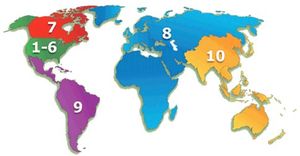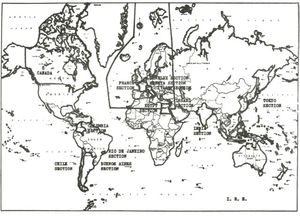IEEE Region 8 (Europe, Middle East, & Africa) History
Are you a member of this region? Please help expand the article by using the edit tab.
History of Region 8
Region 8 was created when the American Institue of Electrical Engineers (AIEE) and the Institute of Radio Engineers (IRE) merged in January 1963. However, its seeds were planted by the IRE which, unlike the AIEE, was a transmational society with Sections outside the USA.
The IRE initially had seven Regions in the USA, Canada was Region 8, and there were no Regions in other countries, although Sections existed. However, on April 24, 1962, IRE approves the formation of Region 9 and onon 12 May 1962, shortly before the merger, the IRE created Region 9. The new region comprised twelve Sections in other countries, seven of these Sections being in Europe, Benelux, Egypt, France, Geneva, Israel, Italy, UK & RI. Dr. Rinia (Benelux) was the first director of Region 9 1962-1963.
At the time of the merger it was agreed that the IEEE should continue the transnational concept. The IRE type of structure was adopted, but revised: the number of Regions in the USA was reduced from seven to six; Canada became Region 7; Europe, the Middle East, and North Africa became Region 8 on 8 January 1963, which is therefore the date on which our Region was founded; other parts of the world were covered by Region 9. The present Regional structure resulted from later changes: in 1966 South America became Region 9, with Region 10 covering other parts of the world; finally in 1981 the remainder of Africa become part of Region 8.
Some recollections of the Eastward spread of IEEE Sections in Region 8
In the days before the end of the Berlin Wall, and the associated political changes in Eastern and Central Europe, IEEE activity in the countries east of the ‘Iron Curtain’ was limited. There was a Poland Section in Region 8, formed in 1972, and occasional IEEE related conferences had taken place there. Other International Organisations such as IFAC and IFIP were rather more successful in organising conferences in this part of the world, because of the way that they had ‘representatives’ of each country in their management bodies.
The Hungary Section was formed in 1987, and the Region 8 Committee held a meeting in Budapest in April 1989.
After the changes, there was a rapid development of IEEE activity and formation of new Sections. A Region 8 Committee meeting was held in Warsaw, Poland, in Spring 1991 during what were still difficult economic times for Poland.
However, growth in membership numbers was (and still is) slow. The economic changes meant that IEEE membership was unaffordable for many professional engineers and academics. Senior members of national research institutes were often able to join using other than personal funds, but in a few cases, they regarded IEEE membership as something of a privilege which they were reluctant to share with junior colleagues.
Somewhat later, the R8 Committee held several more of its meetings in the Central and Eastern European areas: Prague, Czech Republic, in 1994, Berlin, Germany in 1999, in what had been East Berlin (part of the former GDR), then at Budapest, Hungary in 2002 and at Kraków, Poland in 2004. The Czechoslovakia Section was formed in 1992 and despite the split of Czechoslovakia into the Czech and Slovakian Republics, a single Section for both has been retained, although that may not be sustainable in the long term.
Russia was something of a special case – a huge country with many locations which have extensive Scientific and Engineering activity at a high level – where one might expect, in the long term, to see many IEEE activities develop. However after the IEEE Russia Section was formed in 1990, membership growth was very slow, mainly for economic reasons, although many Chapters were formed, partly with the aid of a financial support initiative from some IEEE Societies, especially from Electron Devices, and who paid for initial memberships so that Chapter formation petitions could be created, and there were a number of IEEE conferences held. Chapter Chairs meetings were held in various places in Region 8 with financial support from Societies in Division I and IV and from Region 8, generally alongside the major conferences of one of the Societies, and the support was enough to pay for the attendance of Chapter Chairs from many of the Central and Eastern European locations. The Microwave Theory and Techniques Society was also very active in this initiative and still is. This led to several similar Chapter Chairs meetings for other Societies being initiated by the Region 8 Committee (for example, one for Signal Processing Chapter Chairs alongside the ICASSP in Istanbul, Turkey in June 2000).
However, Chapters in parts of Russia remote from Moscow sometimes complained of lack of support from their Section, and after a while moves to provide some independence for activities in St. Petersburg and Siberia arose. After some suggestions to form a Russia Council were abandoned, there was finally agreement to form three Russia Sections, one to be called ‘North West’ and one ‘Siberia’ – while the original Russia Section retained responsibility for all other parts of the country. Existing Chapters were transferred to the newly formed Sections where the location of their principal activities justified it.
Another "problem" with some of the new Chapters was an unwillingness of the initial Chapter Chairs to hold elections and be replaced by other volunteers, resulting in some very long-serving Chairs. This also happened with a few of the new Sections. In the Ukraine Section, there were strong ‘differences of opinion’ between a Chapter in the East part and another in the West part!
When the three Baltic Republics (Estonia, Lithuania and Latvia) gained their independence from Russia, there was a suggestion from the Region 8 Committee management to try to form a single ‘Baltic’ IEEE Section, combining the three countries. There was a mistaken belief that they were all rather similar, with languages incorrectly assumed to be Slavic! It took some persuasion to convince some senior R8 IEEE volunteers that this was not the case, and that each had a very different language and culture.
An early step was the formation of a Chapter in Estonia, which was affiliated with Finland since there was no Estonia Section. I had the pleasure of announcing the formation of this Chapter to the Region 8 Committee when they met in Piscataway in Spring 1998. To the puzzlement of all except the IEEE Finland Chair, I preceded my announcement by asking the Committee to listen to some music played over the audio system – this was a recording of the Estonian National Anthem, to celebrate the formation of the first IEEE unit in Estonia. It was immediately recognised by the Finland Section Chair because both countries share the same tune for their National Anthems, even though the words are quite different. During the time of the Soviet Union, playing the Estonian National Anthem or showing the Estonian flag were serious offences. Some time passed before the three Baltic countries had their own Sections, with the Latvia Section having only recently been established (in 2008).
As mentioned in the September 1995 interview by Bob Winton (archived at the IEEE History Center at Rutgers University, with a link from the Region 8 website), initial attempts to form a Lithuanian Section involved Prof. Raimundas Jasinevicius, from Kaunas University of Technology, who had established links with Universities in London, England many years before, for the exchange of junior academics, etc. Progress with Section formation was very slow and made slower by his absence in Denmark for six years as Lithuanian Ambassador. However, the Section was finally established in 2005, based mainly in Vilnius. This was followed by the Estonia Section formation in 2006.
IEEE activities in the former Yugoslavia were another special case. The Yugoslavia Section was formed in 1971 (or 1985, according to their website), and became moderately active in holding conferences and in providing IEEE volunteers. Because of a ‘blocked currency’ situation, USA, but an arrangement was made to keep the funds in Yugoslavia where they could be utilised for organisation of local IEEE conferences and also could be used to pay the local costs of conference attendance there by visitors from Western countries, who could then reimburse IEEE in USA. Following the wars in Yugoslavia, Slovenia and Croatia first split away to form their own Sections, and later Bosnia and Herzegovina formed a separate Section. Calling the residue of the original Section by the name Yugoslavia became an increasing anomaly, and in 2005, it was renamed the Serbia and Montenegro Section
Because of a number of rather new Sections wanting to host the R8 Committee, and because the R8 Committee management was glad of the opportunities to welcome these new Sections by meeting on their territory, the Committee meetings were held in Vilnius, Lithuania, in 2006 and in Sofia, Bulgaria and Bucharest, Romania, in 2007.
The next few meetings of the R8 Committee are likely to be in Western Europe, and so the long term average will seem more balanced.
Prof. Tony Davies
8 June 2008
Section Formation dates
- 5-Oct-1954 ISRAEL
- 8-Sep-1955 EGYPT
- 13-May-1959 BENELUX
- 13-May-1959 ITALY
- 10-Jul-1960 U.K. & IRELAND
- 13-Dec-1960 SWITZERLAND
- 17-Oct-1961 FRANCE
- 28-Mar-1963 NORWAY
- 22-Apr-1963 GERMANY
- 29-Mar-1965 SWEDEN
- 16-Apr-1968 SPAIN
- 18-Aug-1968 DENMARK
- 12-Feb-1970 IRAN
- 17-Mar-1970 GREECE
- 21-Jun-1971 SERBIA and MONTENEGRO
- 12-Jun-1972 FINLAND
- 1-Dec-1972 POLAND
- 5-Aug-1977 SOUTH AFRICA
- 12-Jan-1978 NIGERIA
- 21-Dec-1979 AUSTRIA
- 5-Jun-1981 SAUDI ARABIA
- 4-Dec-1981 PORTUGAL
- 19-Nov-1982 KENYA
- 20-Jun-1987 UNITED ARAB EMIRATES
- 21-Aug-1987 HUNGARY
- 18-Nov-1988 WESTERN SAUDI ARABIA
- 18-Aug-1989 TURKEY
- 20-Feb-1990 KUWAIT
- 15-Aug-1990 ROMANIA
- 15-Aug-1990 RUSSIA
- 21-Nov-1991 UKRAINE
- 1-Aug-1992 CROATIA
- 1-Aug-1992 CZECHOSLOVAKIA
- 1-Aug-1992 SLOVENIA
- 30-Jun-1993 CYPRUS
- 24-Jun-1995 BULGARIA
- 14-Feb-1997 REPUBLIC OF MACEDONIA
- 12-Nov-1999 JORDAN
- 24-Jun-2000 ICELAND
- 23-Jun-2001 BAHRAIN
- 15-Feb-2002 BELARUS
- 13-Feb-2003 RUSSIA (NORTHWEST)
- 13-Feb-2003 RUSSIA (SIBERIA)
- 18-Nov-2004 LEBANON
- 18-Nov-2004 MOROCCO
- 18-Nov-2004 QATAR
- 18-Jun-2005 LITHUANIAN
- 12-Nov-2005 BOSNIA AND HERZEGOVINA
- 18-Feb-2006 OMAN
- 26-Jun-2006 ESTONIA
- 18-Nov-2006 MALTA
- 16-Feb-2008 LATVIA
- XX-Jun-2008 TUNISIA
- XX-XXX-???? LIBYA
- ??-??-???? ALGERIA
Further Research
Region 8 Centennial Review , issued in 1984 for the 100 years of IEEE.
Early history of Region 8 and the UKRI Section] by Bob Winton, Mick Byford, and Robert Williams. An Interview Conducted by William Aspray on 4 September 1995 for the IEEE History Center.

